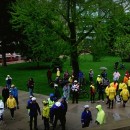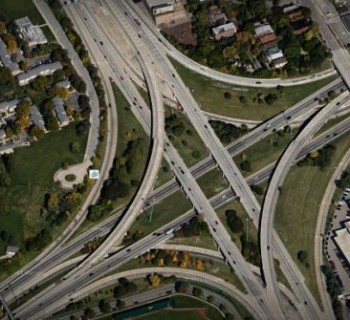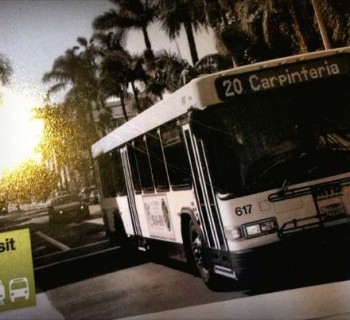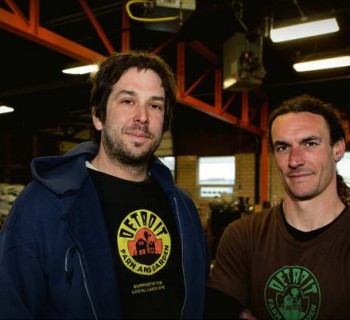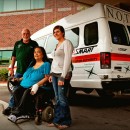HIGHLAND PARK, Mich.—Nathan Ayers, a permaculture educator from Ann Arbor, stands inside of the “Kratergarten” he recently helped create in Highland Park. Ayers is the director and head research instructor for Chiwara Permaculture, a Michigan L3C that uses ecological principles and ethics to address community-based problems. The organization has sites in Ann Arbor, Highland Park and Beaver Island.
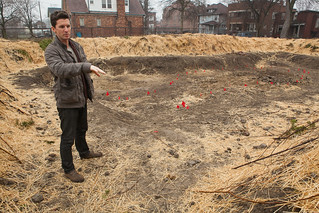 Ayers was first introduced to Highland Park in 2010.
Ayers was first introduced to Highland Park in 2010.
“I just immediately fell in love with the story of what’s going on around here. We’re about 500 yards from the original Henry Ford Model T factory…it’s one of the few places in the world where you can really see the full cycle of Western industrialization from start to finish,” he says.
Ecological design principles
The Kratergarten that Ayers is standing in was pioneered by Sepp Holzer, an Austrian permaculture expert. Holzer joined Ayers and 60 other participants in Highland Park to create the installation. This is the second installation that Holzer has helped to create in Detroit; the first project was done at Catherine Ferguson Academy.
This Kratergarten sits next to The Hive 116, a cooperative residence in Highland Park that also functions as an education and research center.
Kratergartens allow farmers to triple the amount of growing space, catch and store water efficiently, and serve as microclimates to potentially extend the growing season.
Ayers says that even during March, his personal Kratergarten was inundated with Kale. “We don’t need to be sending all this money to California and Chile and places like that for veggies, we can do that here for sure.”

With the help of an excavator, Chiwara’s team created this Kratergarten in one day. The team first scraped off all the topsoil and humus. Once the earthwork has been done, the topsoil and humus is then put back on top, and that becomes the growing medium. The food is grown in the raised beds.
In this installation, the bottom level contains root crops like potatoes and squash, the middle tier is composed of plants such as lettuce and radishes, and the top floor will grow tomatoes and berry bushes.
“This is not a traditional community garden, this is a research and education based garden," Ayers says. "The goal here is to research how we can best grow food, and empower other people to do it the same way. Community based R&D is what we’re doing. We’re trying to figure out new solutions, what can work here.”
The philosophy of working with nature
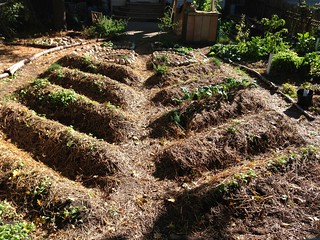 Ayers said that last year, utility companies raised water rates in Highland Park by 29 percent. This is important for Chiwara as a community-based R&D business because it is demonstrating that it can terraform landscapes to catch and harness water efficiently.
Ayers said that last year, utility companies raised water rates in Highland Park by 29 percent. This is important for Chiwara as a community-based R&D business because it is demonstrating that it can terraform landscapes to catch and harness water efficiently.
“Through good permaculture design, we want to demonstrate how we can remediate these landscapes with plants.”
Chiwara works to create a new generation of nature-based problem-solvers, and uses a whole systems approach.
“That’s the M.O. of permaculture: trying to get folks in a new relationship with nature,” he says.
Ayers believes one of the biggest issues with traditional farming is soil conservation. “We’re losing over two billion tons of topsoil every year, and if we don’t figure out ways to make soil sexy and interesting, we’re going to see some serious problems in this country.”
"... the major philosophical difference that I think our courses help bring about in people is the transition between a consumer to a producer." ~ Nathan Ayers
Within permaculture, the agricultural approach is based on nature. According to Ayers, Chiwara seeks to “mimic biodiversity that we would find in natural ecosystems.”
Chiwara just happens to be using a lot of plants that are edible for humans. Agriculture in permaculture is far less energy-intensive than traditional farming. Ayers noted that one person can really maintain the entire Kratergarten.
“There’s definitely work involved in the front-end: putting in fruit trees, and terraforming landscapes, but then after these systems get set up, they take care of themselves. That’s the idea. The model for all of this is a forest, and a forest doesn’t need to be watered,” he says.
Transitioning from consumer to producer
“Reconnecting with source is one way—taking responsibility for where our food and energy comes from. But the major philosophical difference that I think our courses help bring about in people is the transition between a consumer to a producer. And that’s a big, big deal,” Ayers explains. “We’re all consumers now. It’s just the nature of the lives that we’ve led and how things have evolved in the United States. We’ve gotten really good at cheaply producing things for people so they don’t need to worry about where their food’s coming from.
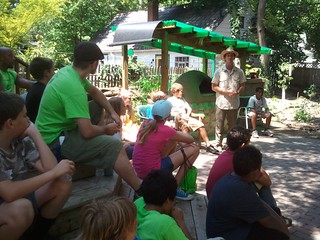
“Why I’m such a strong advocate for permaculture is that I think it really gives people the tools they need to take responsibility for themselves, and make that transition from being a consumer to being a producer. Being a producer of their own food, of their own energy, of their own water systems, and things like that. That’s a major philosophical difference; it’s an entirely different operating system.”
In addition to leading Chiwara, Ayers also teaches permaculture at Washtenaw Community College. He became interested in permaculture after 2005, when he became active in Ann Arbor’s “green scene.” He learned from Wayne Weisman and Bill Wilson, two prominent permaculture instructors. In 2009, Ayers took his permaculture certification course in California.
“I think permaculture can be an absolutely tremendous vehicle for re-localization, and not just food, but energy, transportation and building infrastructure. If we change around our food systems it can address so many other societal, economic and ecological issues.”
Chiwara Permaculture offers educational courses to individuals in K-12, college, and the general public.
To learn more about participating in courses at Chiwara, visit their website or e-mail Nathan Ayers.



